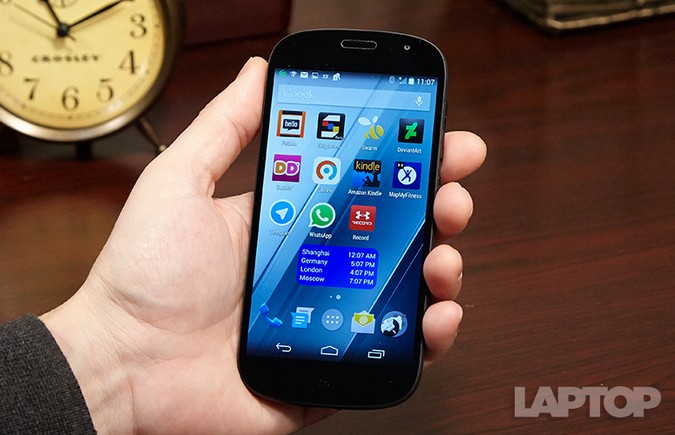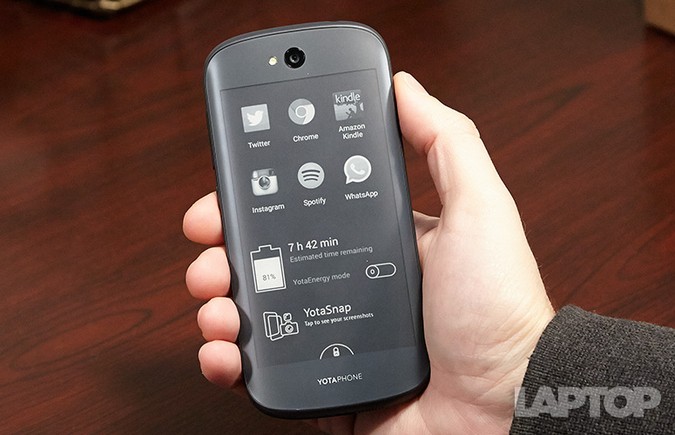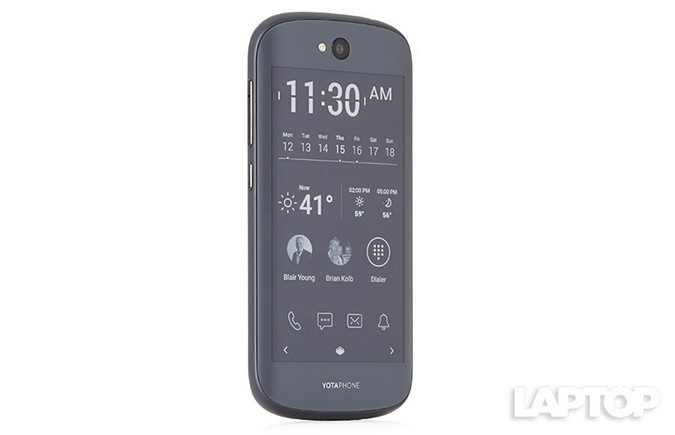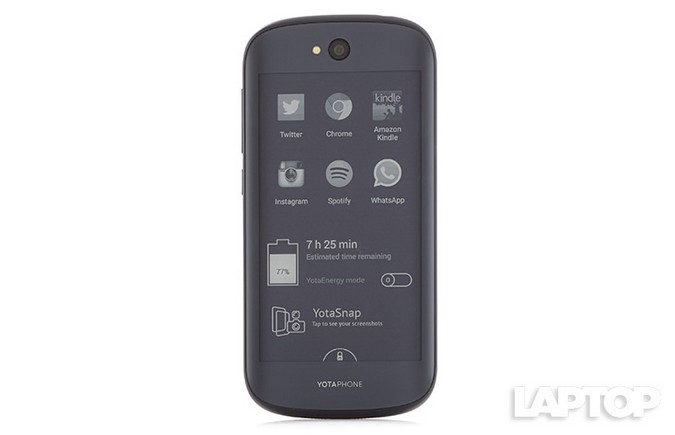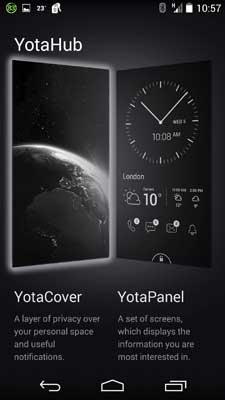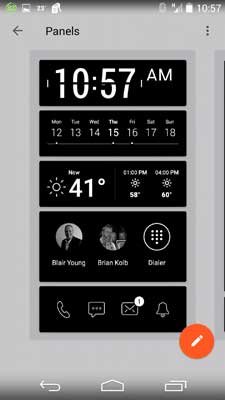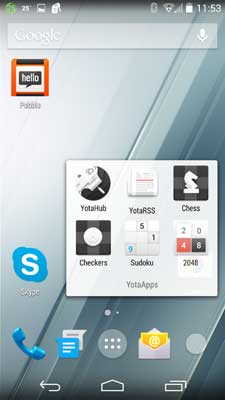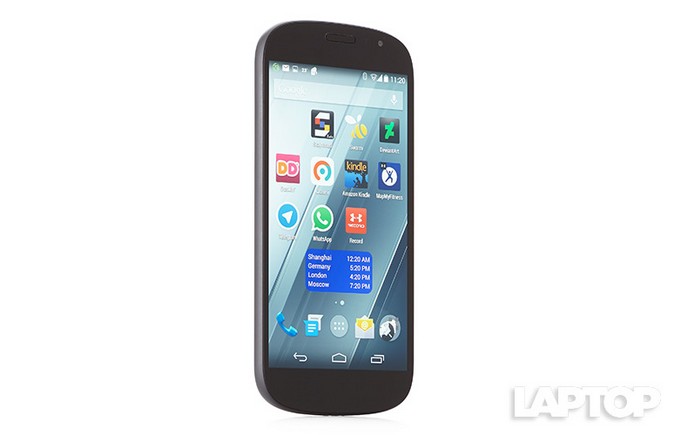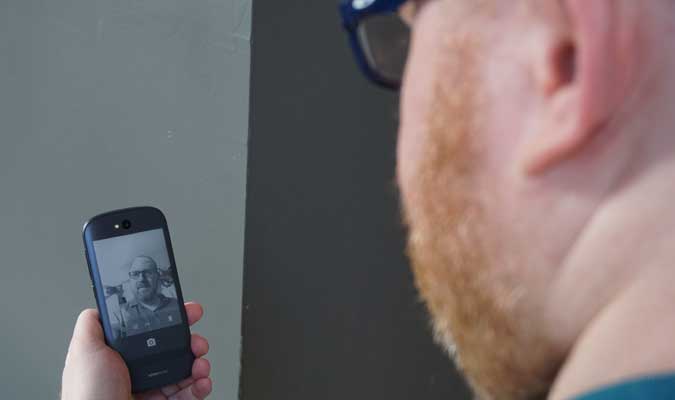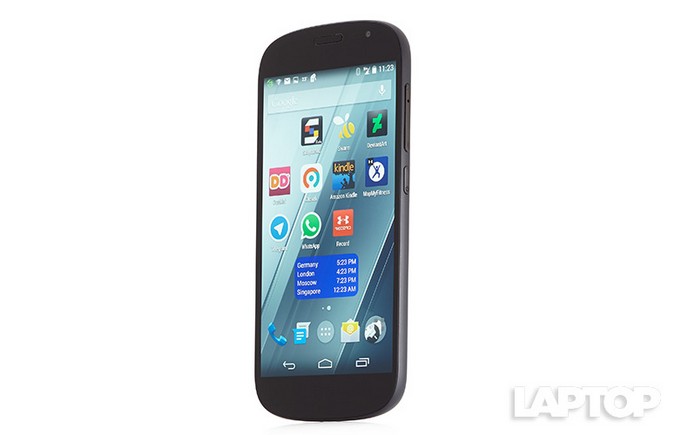Laptop Mag Verdict
The YotaPhone 2 is an innovative dual-sided phone that lets you do all sorts of things with its power-sipping e-paper screen, but it's a very expensive combo.
Pros
- +
Innovative second display
- +
Quick alerts when phone is facedown
- +
Sharp primary display
Cons
- -
Primary display has mediocre endurance
- -
Last year's CPU
- -
No LTE option yet
- -
Pricey
Why you can trust Laptop Mag
The mullet of smartphones , the YotaPhone 2 has color-screen business in front and an e-paper party in the back . Like the original YotaPhone, the Android-based sequel sports a low-power, gray-scale display on its backside that remains on 24/7 to show you updates or allow you to perform simple tasks while using very little battery life. The new model ups the ante with a faster processor; a larger, 5-inch full-HD display; and more rear-screen functionality. However, to justify the YotaPhone 2's high price ($850 / 555 British pounds unlocked), you'll have to really love its signature feature and be willing to accept some trade-offs in specs and software.
Availability and Network
At present, the YotaPhone 2 is only available as an unlocked import and, as such, provides only HSPA+ connectivity over GSM networks (T-Mobile and AT&T) in the U.S., though it supports LTE bands that are used in other countries. However, the company recently announced that it plans to bring the phone to a U.S. carrier, which, we presume, would offer full 4G LTE support, a lower price and potentially better battery life. There are no further details about which carrier(s) might support it, or when it will arrive.
[sc:video id="l4ZG9zcjr-QRVfr1r3Ikaj5fFDm7lLEl" width="575" height="398"]
Design
From the front, the YotaPhone 2 looks unremarkable, with a shiny, black bezel surrounding its 5-inch screen and black plastic sides. The front surface is completely devoid of any logos or symbols; YotaPhone doesn't provide hardware navigation buttons like Samsung or HTC, and instead uses Android's built-in software home, back and multitasking buttons.
At 5.7 x 2.7 x 0.35 inches and 5.11 ounces, the YotaPhone 2 is the same weight as the Samsung Galaxy S5 (5.1 ounces) but a little thicker (5.3 x 2.9 x 0.25 inches). HTC's flagship One M8 (5.8 x 2.8 x 0.37 inches, 5.6 ounces) is both thicker and heavier, while the iPhone 6 (which has a smaller, 4.7-inch display) is quite a bit smaller.
Sign up to receive The Snapshot, a free special dispatch from Laptop Mag, in your inbox.
The back surface of the phone contains its 4.7-inch, e-paper display. Though you have to touch the back screen to pick up the phone, the matte gray-scale panel was as easy to grip as the back of any phone.
MORE: Best Smartphones
E-Paper Display
The YotaPhone 2's rear e-paper display provides a second and unique way to use the phone. Because the gray-scale screen uses electricity only when it changes modes, it stays alive even when the phone is asleep or powered off, and it helps you conserve battery power. In addition to providing short updates, the second screen can serve as an e-reader, an always-on reminder of important info or even a full-fledged gray-scale display for the phone itself.
I found the 4.7-inch, 960 x 540-pixel touch-sensitive panel sharp and easy to read, both indoors and outside. However, while the e-paper screen was snappy and responsive to most touches, a few buttons required very deliberate or repeat touches to register. In particular, I found unlocking the back panel to be frustrating -- it locks itself just like the front screen -- because I often had to swipe two or three times for the phone to recognize my gesture.
Though the device uses a very stock-looking version of Android 4.4 KitKat, YotaPhone has integrated support for the gray-scale display into the OS. When you swipe up from the home button, you're presented with a menu that offers buttons for launching "mirror mode" or sending a static screen to the back panel, in addition to the standard Google Now button you get on every Android phone.
Mirror mode simply turns the rear display into the primary display, allowing you to navigate through the Android UI and use all your apps in 16 shades of gray. I found the phone relatively swift and responsive in mirror mode, whether I was surfing the Web or browsing my contact list . I was even able to use the camera app to take a rear camera selfie in this mode. The e-paper screen will also come in handy for streaming music or GPS navigation; the latter activity really sucks down the power in color-screen mode. However, I think the novelty of using an e-paper display for every task would wear off quickly.
The screenshot mode is useful, as it simply pins a still image of the current display contents to the rear panel. When I searched for the address of a place I wanted to go, I used this feature to place the Google result on the back, where I could see it without waking the device. You could also use this mode for things like airline boarding passes.
When it's not in a special mode or running an app, the rear display shows the YotaCover, a simple wallpaper with shortcut icons to your email, text messages, phone dialer and general alerts; or a YotaPanel containing widgets like a clock and the current weather, along with the same four shortcuts. Tapping the email shortcut gave me complete access to my inbox.
One YotaPanel contains a news feed, which I configured using the included YotaRSS app. It shows one headline (and photo) in the panel, but there's a button you can press to view a scrollable list of headlines. When I tapped on each headline, I saw truncated versions of the stories with photos on top. A different panel -- with the latest email, SMS and missed calls on it -- was more practical.
The phone also includes a few special rear-panel apps. YotaReader turns the gray-scale display (or the primary color panel) into a dedicated e-reader. An included book of Hans Christian Andersen's fairy tales looked crisp on the e-paper screen, and pages turned quickly as I swiped right to left. The reader allows you to import free books from catalogs such as Project Gutenberg.
The YotaPhone 2 also has a few gray-scale games, including chess, checkers and Sudoku. The chess game has good graphics and a useful peer-to-peer mode, which allows you to play other YotaPhone users within Bluetooth range. However, I found that I often had to tap the screen several times and press really hard to get it to register my moves.
Primary Display and Audio
While not as innovative as its gray-scale counterpart, the 5-inch, 1080p primary AMOLED display provides sharp, colorful images. When I played a full-HD trailer for the Avengers: Age of Ultron, colors such as the red in Iron Man's armor and the green in the Hulk's skin appeared particularly vibrant, though a little yellow. Because of the screen's high pixel density (441 ppi), objects on screen appeared detailed and free from noise.
I was able to see the screen clearly outdoors, and it appeared very bright to my naked eyes. However, the panel measured 329 nits on our light meter, which is a bit below the 371-nit category average and the HTC One M8's 402 mark.
Whether I was playing a trailer for Avengers: Age of Ultron or shooting enemies in N.O.V.A. 3, the sound was loud and accurate. Throughout my use, the audio was rich and free from tinniness.
Android UI and Software
With the exception of adding rear-screen functionality and apps to the handset, YotaPhone has done nothing to alter Google's stock version of Android 4.4 KitKat. Purists will love the software buttons, the clean look, the unmodified default apps and the complete absence of system-slowing third-party skins.
However, Samsung, HTC and LG add a lot of innovations to their phones that you won't find on the YotaPhone 2, including multiwindow modes, enhanced app drawers and a bevy of superior camera features. The stock Android keyboard seems particularly spartan when compared to Samsung's keyboard and its powerful next-word prediction and well-spaced keys. On the bright side, the YotaPhone 2 has very strong haptic feedback, which made typing on its screen feel more like doing so on a physical keyboard.
MORE: 5 Ways to Speed Up Your Android Phone in Under 5 Minutes
Camera
The YotaPhone 2's 8-megapixel camera takes photos and full-HD videos that are more than sufficient. Outdoor photos of a city skyline looked sharp and colorful, though dark areas were particularly shady. A 1080p video of cars rolling down a road on a sunny day was smooth and detailed, but also a little dark. An indoor flash picture of a hotel room had a minimal amount of noise.
The front, 2-MP camera took bright, colorful images of my face on a sunny day and relatively sharp pictures in low light.
Interestingly, when I was in mirror mode and launched the camera app from the e-paper display, I was able to take even sharper selfies using the rear camera is if it were the front. Though the grayscale display doesn't refresh as quickly as the color one, it was more than adequate for viewing a live camera preview.
The device uses the stock Android camera app, but adds the neat effect of showing a picture of a camera with the word "Smile" on the e-paper display while you are shooting.
Performance
With its quad-core, Snapdragon 800 processor and 2GB of RAM, the YotaPhone 2 offered snappy, lag-free performance, whether we were browsing the Web, navigating through the app drawer or playing a game of the first-person shooter N.O.V.A. 3.
However, the Snapdragon 800 chip is older and slower than what you'll find in today's flagship phones. On Geekbench 3, which measures overall performance, the handset scored a solid 2,466, which is a bit higher than the category average (2,309) but well behind the Snapdragon 805-powered Galaxy S5 (2,931) and A8-powered iPhone 6 (2,931).
The YotaPhone 2 had no problem with 3D gaming or HD video playback, so we weren't surprised that it scored a strong 15,735 on the 3DMark Ice Storm Unlimited test. That's comfortably above the category average of 15,431, but well below its newer competitors, including the Galaxy S5 (18,204) and the HTC One M8 (20,640 ).
Battery Life
If you buy the YotaPhone 2, you're probably going to need its rear display to get through the day. The phone and its 2,500-mAh battery lasted just 5 hours and 52 minutes on the Laptop Mag Battery Test, which involves continuous Web surfing over 4G on AT&T's network at 150 nits of brightness. That time is well behind the smartphone category average of 8 hours and 37 minutes and the Galaxy S5's time of 9:42.
To be fair, our phone was an unlocked version that we populated with an AT&T SIM card. When the phone officially launches with a U.S. carrier, it might be better tuned to the networks here. Or, it might do even worse if it has to use LTE, which typically sucks more juice than HSPA+.
In my anecdotal use, however, the phone lasted through several days of standby and periodic use. Users who rely heavily on the rear display for notifications will also see a nice boost in real-world battery life, because the e-paper screen uses no power to stay on and much less to update than the primary panel. Typical smartphone users unlock their phones 150 to 200 times a day to check notifications, so if the rear display radically changes that behavior, YotaPhone owners will see big gains. However, the secondary display's lack of a rich social feed (it has Twitter updates on panels, but not Facebook or Google+ yet) or instant messaging notifications would have me reaching for the color display on a regular basis.
Bottom Line
The YotaPhone 2 is a solid Android phone that has a truly unique and compelling feature: its rear-facing e-paper display. You'll enjoy unparalleled outdoor readability, handy customizable dashboards and much longer battery life compared to the color screen. The second display is almost like having a second device -- which you can use for reading, streaming music and other tasks that don't need the full-color treatment -- to save power. However, other flagship phones have faster CPUs, more capable cameras and sharper primary screens.
Whether you intend to pay to import the phone at a relatively high cost or want to wait for it to hit a U.S. carrier, what you're paying for is the e-paper experience, which you might not need as badly if you get a phone with longer endurance on its primary display. However, if you love the secondary display and all the neat features that come with it, the YotaPhone 2 won't let you down.
- 10 Smartphones with the Longest Battery Life
- The Most Expensive Smartphones in the World
- 25 Best Android Apps
Yota Phone 2 Specs
| Alternate Carriers | AT&T, T-Mobile |
| Brand | YotaPhone |
| CPU | 2.2-GHz Qualcom Snapdragon 800 |
| Carrier | Unlocked |
| Company Website | www.yotaphone.com |
| Display (main) | 5 inches, 1920 x 1080 LED |
| Display (secondary) | 4.7 inches, 960 x 540 ePaper Display |
| Display Resolution | 1920x1080 |
| Form Factor | Dual Screen |
| GPS | Yes |
| Internal Memory | 32GB |
| OS Family | Android |
| Operating System | Android 4.4.2 |
| Phone Display Size | 5 |
| Processor Family | Qualcomm Snapdragon 800 |
| RAM | 2GB |
| Size | 5.7 x 2.7 x .35 inches |
| Weight | 5.1 ounces |
| Wi-Fi | 802.11ac |

